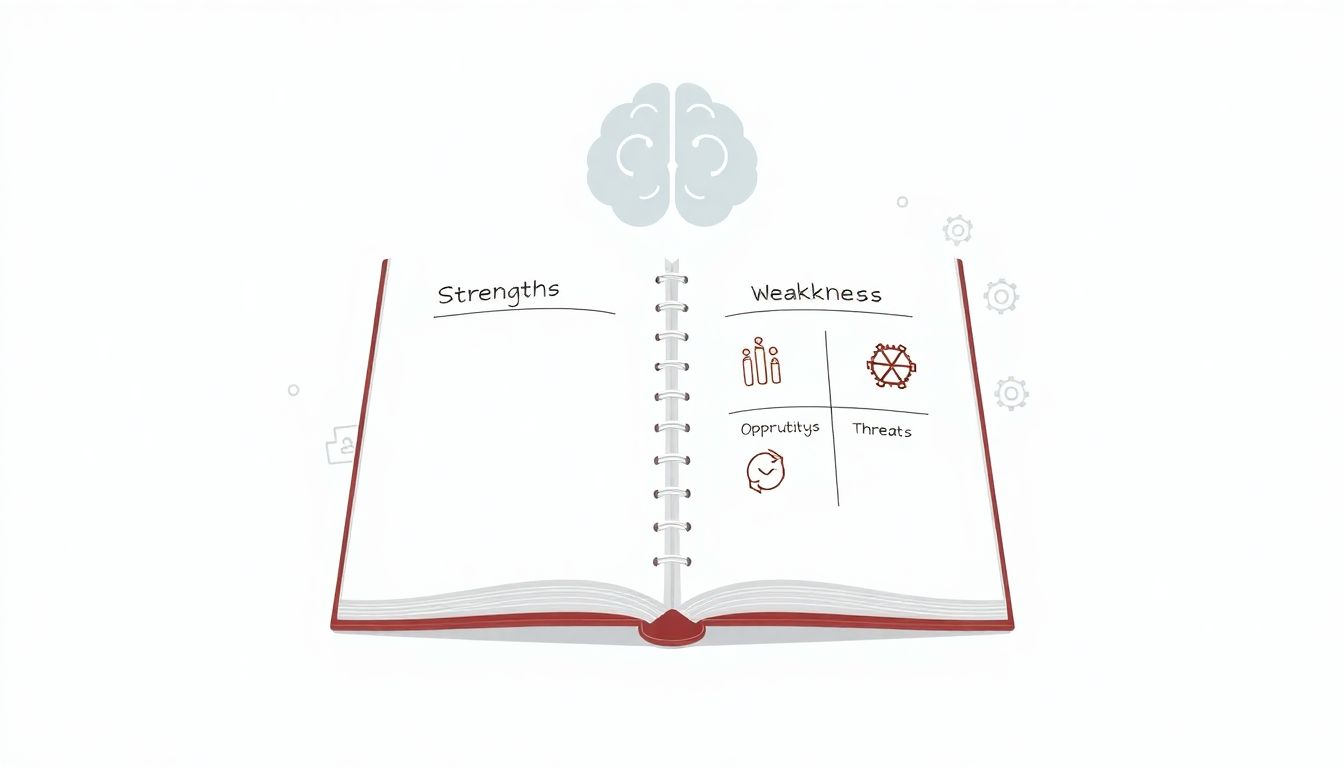Have you ever felt overwhelmed while trying to nail down a SWOT analysis? You’re not alone! Juggling strengths, weaknesses, opportunities, and threats can feel like solving a Rubik’s Cube in the dark—frustrating and confusing.
But what if I told you there’s a way to make this process smoother and more enjoyable? By integrating ChatGPT into your SWOT analysis, you can uncover insights faster and spark creativity like never before. Stick around, and I’ll show you how to supercharge your analyses!
From practical tips to common prompts, we’ll explore how ChatGPT can be your trusty sidekick in navigating the complexities of SWOT. Let’s dive in and unlock a whole new world of analytical possibilities!
Key Takeaways
- Integrate ChatGPT into your SWOT analysis to uncover insights faster and boost creativity.
- Use specific prompts for strengths, weaknesses, opportunities, and threats to get focused responses from ChatGPT.
- ChatGPT helps streamline the analysis process, making it more efficient and accurate.
- Utilize common prompts to kickstart your SWOT analysis, tailored to your industry and context.
- Cross-check AI-generated insights with your own knowledge for accuracy and relevance.
- Promote teamwork by sharing ChatGPT insights for a richer analysis experience.

How to Use ChatGPT for a Better SWOT Analysis
Using ChatGPT for a SWOT analysis involves harnessing AI-driven insights to enhance your strategic planning processes.
Start by gathering relevant data about the business or project you are analyzing.
Then, provide ChatGPT with specific prompts to generate detailed insights on strengths, weaknesses, opportunities, and threats.
For example, you can ask, “What are the potential strengths of [Your Company] in the [Industry]?”
This not only automates part of the analysis process but also invites a diverse perspective that can uncover factors you may not have considered.
Overall, integrating ChatGPT allows you to streamline the SWOT analysis and improve its accuracy with AI assistance.
Benefits of Integrating ChatGPT into SWOT Analysis Processes
Integrating ChatGPT into your SWOT process offers multiple advantages, starting with improved analysis accuracy.
The AI can analyze large datasets quickly, pinpointing trends that may enhance your insights.
Another significant benefit is efficiency; the time required to gather and analyze data is drastically reduced.
This means you can focus on interpretation and strategy rather than data collection.
ChatGPT also provides detailed insights, which can lead to a more comprehensive understanding of the factors at play.
Moreover, it promotes collaborative analysis as teams can leverage standardized prompts and share insights generated through the AI.
Step-by-Step Guide to Crafting a SWOT Analysis with ChatGPT
Crafting a SWOT analysis with ChatGPT is straightforward. Here’s a step-by-step guide to get you started.
First, define the business context or product that you want to analyze.
Next, create prompts for each section of the SWOT. For example:
- “List the top strengths of [Your Company/Project].”
- “Identify the weaknesses of [Your Company/Project].”
- “What opportunities are available for [Your Company/Industry]?”
- “What potential threats could impact [Your Company/Project]?”
Submit these prompts one at a time to ChatGPT for focused insights.
Once you have the outputs, compile them into a structured format.
Lastly, review and verify the generated insights to ensure they align with your knowledge and data.
Common ChatGPT Prompts for SWOT Analysis
If you’re looking to kickstart your SWOT analysis using ChatGPT, here are some effective prompts.
- “Generate a list of strengths for a startup in the tech industry.”
- “What are some common weaknesses that emerging businesses face?”
- “Outline potential opportunities for small businesses during a recession.”
- “Identify threats in the e-commerce sector for 2024.”
- “What are some strengths for a nonprofit organization focused on community services?”
These prompts are designed to be straightforward and functional, helping you unlock valuable insights tailored to your specific analysis needs.

Real-World Examples of ChatGPT in SWOT Analysis
Seeing how others have successfully used ChatGPT in SWOT analysis can provide clarity and inspiration.
One example is a marketing agency that used ChatGPT to analyze its strengths and weaknesses, discovering unique insights about its brand positioning.
The tool generated ideas that helped the agency pivot its strategies to better meet client needs.
Another example is a nonprofit organization that used it to identify opportunities for funding.
ChatGPT produced a comprehensive list of foundations and grants that the organization had overlooked.
A tech startup tapped into ChatGPT for threat identification, which led to the realization of potential cybersecurity risks.
These instances illustrate that whether you’re in marketing, nonprofit, or tech, ChatGPT can provide valuable perspectives for SWOT analysis.
Tips for Improving Your SWOT Analysis Using ChatGPT
To enhance your SWOT analysis with ChatGPT, follow these practical tips.
Start by clearly defining your business context before using prompts.
This helps ChatGPT generate more specific and relevant insights.
Use varied prompts to explore angles you might not have considered, like:
- “What hidden strengths could [Your Company] possess?”
- “List weaknesses of similar companies in the market.”
- “Identify emerging trends that could present opportunities for [Your Industry].”
- “What unforeseen threats could emerge in the next year?”
Moreover, don’t shy away from asking follow-up questions based on previous answers to dig deeper.
Remember to cross-reference the insights generated by ChatGPT with your own knowledge and research.
This validation step ensures you maintain accuracy and relevance.
Lastly, encourage teams to collaborate, sharing insights and refining collective analyses.
Engaging multiple perspectives can lead to a richer SWOT outcome.

Limitations of ChatGPT in SWOT Analysis
While ChatGPT is a powerful tool for SWOT analysis, it comes with certain limitations that users should be aware of.
One major limitation is the interpretation of context; ChatGPT may not fully understand nuances unique to specific industries or situations.
This could lead to suggestions that aren’t perfectly aligned with your organization’s reality.
Additionally, ChatGPT relies on existing data; if there’s limited information available, its insights may be sparse or outdated.
There’s also a possibility of bias in the responses generated, as the AI can reflect biases present in its training data.
It’s crucial to validate the information provided against your own research to ensure accuracy.
Finally, the AI doesn’t possess human emotions or intuition; certain subjective insights that rely on human experience may be missing.
Being conscious of these limitations allows you to complement ChatGPT’s analysis with human judgment.
Best Practices for Using ChatGPT Effectively
To get the most out of ChatGPT for your SWOT analysis, consider these best practices.
Start by formulating clear and concise prompts; clarity leads to better outputs.
For example, instead of asking, “What are some strengths?” you could specify, “What unique strengths does [Your Company] have in the renewable energy sector?”
Second, use iterative questioning; build on previous responses to explore deeper insights.
For instance, if ChatGPT identifies a strength, you might follow up with, “How can we leverage this strength in our marketing strategy?”
Encourage collaboration by sharing the AI-generated outputs with your team for feedback and additional perspectives.
Don’t forget to combine insights from ChatGPT with real-world data and your expertise to ensure relevance.
Finally, regularly evaluate the effectiveness of the insights provided and adjust your approach accordingly.
FAQs
A SWOT analysis evaluates strengths, weaknesses, opportunities, and threats. ChatGPT can enhance it by providing insights, generating ideas, and facilitating brainstorming, leading to a more comprehensive and dynamic analysis.
Common prompts include asking ChatGPT to list strengths or weaknesses, request ideas for opportunities, or identify threats in a specific industry. Tailoring prompts to your unique context will yield the best results.
ChatGPT may lack industry-specific knowledge or context, leading to vague or irrelevant insights. It also cannot replace human intuition or qualitative assessment essential for an effective SWOT analysis.
To improve your process, use clear and specific prompts, incorporate multiple iterations, and refine responses by providing context. Combining ChatGPT’s insights with human expertise ensures a more robust analysis.
